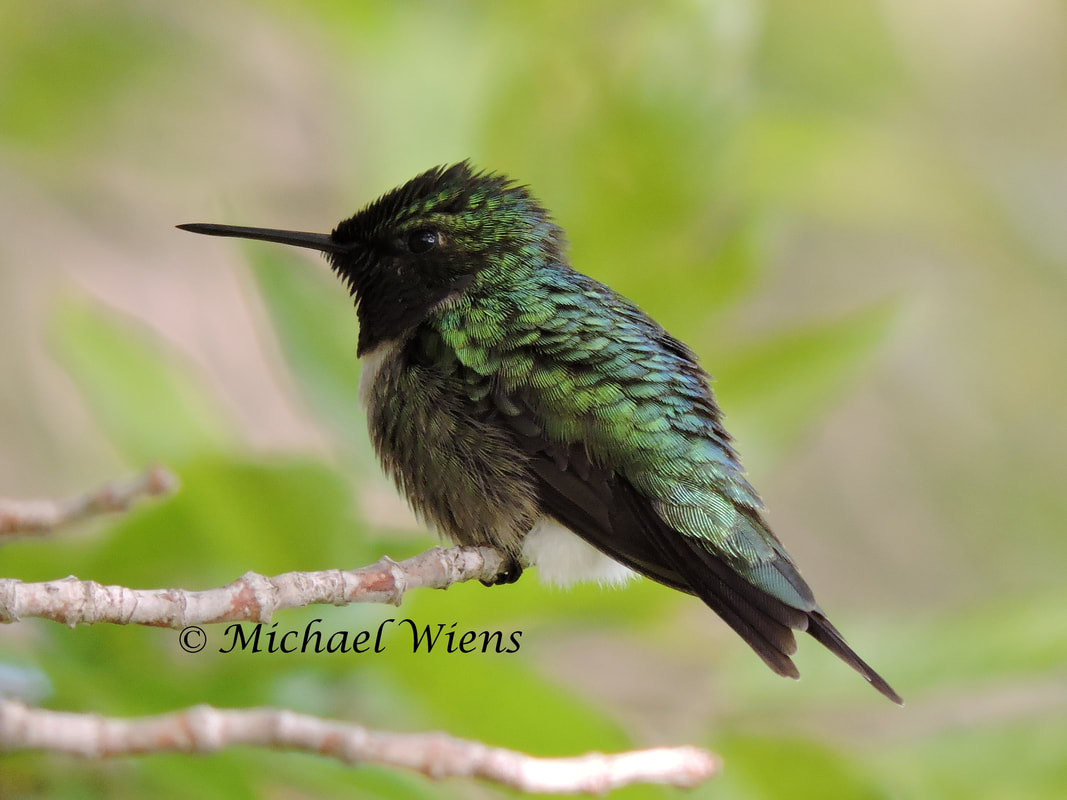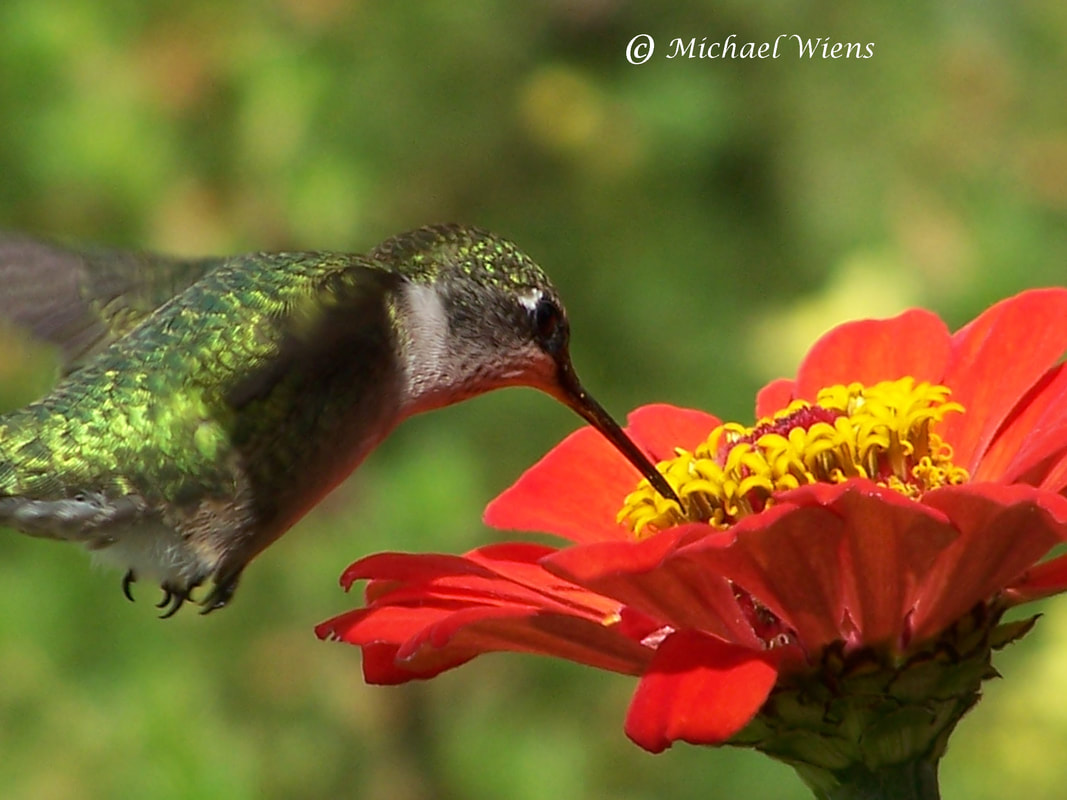Humming Blog |
 Flowers are that instinctive trigger that can instantly change the thoughts of a hummingbird from whatever it's doing to a desire for food. Colors mean food, and food is survival. There is nothing more important to hummingbirds than food because without it they wouldn't exist. They form territories based on food sources, and that should indicate that nothing should matter more to us for attracting them than multiple food sources. Adult birds have learned feeders and realize little effort is required to get a complete fill up every time they visit one. Much effort is required if they want to gain that same amount of food from flowers. It's survival 101 for all living creatures. Gain the most amount of food without having to expend much energy. Because young hummingbirds instinctively gravitate towards flowers, they are unaware that there is something even better out there. This young bird followed its same routine every 30 minutes, feeding from the same flowers because it knew they contained food. So I added a training feeder among the Nasturtiums flowers to try and get its attention. It wasn't exact, but it did the trick after a few passes. Fear of the strange bottle attached forced the youngster to approach with a bit of caution, yet the colors created such intrigue. The juvenile soon plunged its long bill into the feeding port and life would be forever changed. It sat and drank as much as possible. Even then it refused to leave the feeder. It loved this beautiful red thing with the attached orange flowers and licked it from top to bottom. It eventually did leave, but when it returned, the feeder got its attention after a few frustrated attempts at the flowers. They just didn't compare. Although abundant flowers are essential for hummingbirds for those times when feeders are no where to be found, hummingbirds will soon recognize just how important feeders are with their never ending supply of food. This young Ruby-throat sat in the rain and admired its newfound treasure. The water started to bead on its feathers, but it was of little concern. N.E. of Edmonton, Alberta, Canada. August 2017
0 Comments
 Just like a young kitten or puppy, the playfulness is evident in young hummingbirds. For 3 weeks hummingbirds grow up in a nest just big enough to hold the two young. Their safe surroundings are all they know. They reach a point where they start to itch for the outside world and begin with a few clumsy bursts from the nest to nearby branches, and in time they'll make the final escape into a world of intrigue. Colors, shapes, moving objects, and other living things grab their attention. They'll poke and taste everything they possibly can until it's all filed into memory, some things to avoid and others to never be forgotten. Watching how birds behave is one of the easiest ways of identifying whether it's an adult or juvenile. Adult birds will use the least amount of energy to gain the most amount of food, while the young birds will attempt food in the most awkward locations, with nothing off bounds. In the case with this young Ruby-throat, "Freckle", he would bypass not a single flower. It was those deeply hidden flowers that had the least amount of visits, and therefore had the most amount of remaining nectar. It was easy to identify Freckle each time he would arrive, by his one red gorget feather more developed than all the others. Juvenile Male Ruby-throat, N.E. of Edmonton, Alberta, Canada. August 2017  We're nearing a point where millions of migrant birds will start to flood the skies and dress up our gardens with song and beauty. Even the resident birds appear to recognize that special time of year every time we get a Spring-like day. Winter will slowly lose strength over the next 6 weeks and life will begin to blossom across the continent. As colors begin to emerge in the southern U.S. and the days lengthen, the senses of every hummingbird will be tweaked and fine tuned to perform their part in a migration that lasts for a couple months. Every hummingbird, although similar in appearance and character, has had a slight DNA adjustment to make each one unique in the time they start to migrate to each one's behavioral difference. Having a slight tweak performed on each bird allows them to migrate at different times, head to different regions of the continent, and behave slightly different than the rest to oftentimes make us giggle. Each one develops behavioral differences based on their food options, dangers and experiences to shape their unique behavior. One similarity they all have is that when breeding season arrives they develop the most brilliant colors, put on a wonderful display, and demonstrate to us what a really bad attitude looks like. They do the "don't you dare" head shake like the human finger wag, they dominate gardens like they are the authority, but they amuse us with their brilliance and ability year after year. In one short month the Ruby-throats will start appearing along the southern shore of the U.S., and the Rufous will be moving up the West Coast. While we wait, it's a perfect time to start thinking up our garden and feeder strategy to be fully prepared for the time they reach each one of our gardens. Adult Male Ruby-throat hummingbird, N.E. of Edmonton, Alberta, Canada. May 2017  One of the most common questions: Does the color of flowers make a difference in attracting hummingbirds. Well, the answer isn't quite that simple. It has a lot to do with the age of the hummingbird and the food found within the flower. There's not a hummingbird that would bypass a Red or Orange flower if it tasted great. Adult or Juvenile, all shades of red to a hummingbird are like a neon sign to a human. Red is one of those colors that just stand out and pop within a garden. Every young bird new to a garden would quickly be drawn to all shades of Red, which also includes orange. This is NOT to say that it'll taste good. You could have a garden full of red poppies, but the hummingbird would move on if there were other choices. The first colors young hummers go to are the red, but they will sample everything around and then determine which one is their favorite. The mature hummingbirds have a bit of past knowledge to rely on and tend to remember the types of flowers that repeatedly taste great despite color. They will often times bypass a "yucky" red one to head straight to the favorite. Red is a great color to incorporate into your hummingbird garden, but don't rely solely on the color to keep them around. July 2015, N.E. of Edmonton, AB.  Within the first few days of a young hummingbird leaving the nest, they start to realize that if they want food and territory, they will have to compete fiercely for it. Here are two young Ruby Throated Hummingbirds in a unique battle for territory. They continuously rise up and down trying to outlast the other. Sometimes they reach heights of 500-800 ft before one tires out and heads for the ground. Neither gives up easily as they each know as soon as they dive towards the ground, the other one will be right on its tail trying to seriously hurt it. They can dive at speeds exceeding 100km(60mph), and in doing so their wings and tail feathers can create a high pitched screech, sounding like a mini jet as they approach the ground. The one that outlasts the other obviously wins territory and sticks close by until it has another challenger. I call this a jousting battle, and is usually done between the males. Aug. 2015, N.E. of Edmonton, AB.  This was a nervous female that arrived with her two young. All three arrived in the yard at the same time. Her children scattered in opposite directions, got into everything, chased each other, poked at every color they could see and created severe anxiety for her. She flew back and forth, making sure they weren't in any trouble, and eventually they all settled down in the same tree together.(The mother is in the bottom right). The mother separates herself from her young very shortly after leaving the nest with the young. They develop their independence quickly as they learn how to feed, and what to feed from. The minor battles between the siblings turn into intense battles with other hummingbirds, and in no time at all they are fully cable of taking care of themselves, being equipped with abilities far exceeding anything of any other birds. Lessons are taught right up until the time she leaves her young, and they will be ready for life. August 2015, N.E. of Edmonton, Alberta, Canada. |
Archives
June 2024
Categories
All
|
 RSS Feed
RSS Feed
